There are many reasons for measuring the wall thickness of your turned objects. Probably the most important is to achieve a uniform wall thickness in the entire object. The esthetics of having a turning with uniform walls just makes for a nicer and more artistic object. If someone picks up your turning and can tell that the walls are not even they may get a bad impression of your turning even if it looks good from casual viewing. If your turning has very thin walls and hence lightness, you also get a WOW factor from people who will want to know how you did it. Having a uniform wall also makes the object stronger by not having thin spots where you may get a crack. An open form such as a bowl will be relatively easy to check the walls whereas a hollow form may have a small opening and it could be hard to tell if the walls are the same. Hopefully this paper will give you an idea of the many ways that you can achieve uniform wall thickness on all your turning projects. Besides itís just THE RIGHT THING TO DO. I have listed many ways of measuring your turnings with the advantages and disadvantages noted. These techniques have been arranged from what I feel is the most basic to the most advanced.
This is the most basic and primitive of your measuring tools. You can tell right away if you have a problem if you can get your fingers in to do some feeling. Very, very small differences in wall thickness can be easily felt. This is where your fingers do their best work, feeling for bumps and dips. These dips and bumps, which canít be easily seen, are easy to feel. One problem with your fingers is you canít tell how thick an object is. You may be able to guess but itís very hard to tell the difference between 3/8" and 1/4" with only your fingers. The other problem is you have a limited reach with your fingers, approximately 2íí at the most. This may be a limitation for you but itís also an advantage, as nobody else can feel much further than you can.
Holes in the wood are a natural for seeing how thick or thin your turning is. You may have only one hole or several but this can help you see exactly what the wall thickness is at that point. If you are doing any cutting or carving away of the walls you may be able to drill one or several holes in the wall where you are going to be cutting away material, this will be a easy way to tell your wall thickness. I can think of no disadvantages for this technique.
This is another very basic method of determining wall thickness. When you get the right sound from tapping on the turning you know that the wall thickness is OK. The higher the note the thinner that the turning is. People that are hard of hearing or are wearing hearing protection may not be able to use this technique. The only problem with this technique is it takes practice to find out what the correct sound is. Also different shapes will give different sounds. It is possible that you will ruin some turnings before you can learn this sound.
This technique is similar to the one above accept that you do not have to turn off the lathe in order for you to have a good idea of the wall thickness. When the tool is cutting you get a certain sound, as the wall gets thinner the sound will get a higher tone to it. If the sound of the wood turning keeps getting higher you are getting thinner. If the sound gets higher then goes away it means you have gone to far and will have to start over. If you turn the same or similar forms more than once you can learn what the correct sound is and quit while your ahead.
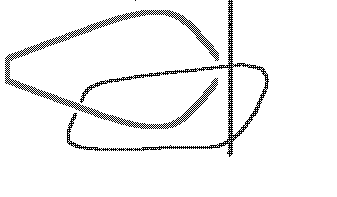
This is a good method for hollow forms but will work on open forms as well. There are many advantages to using a bent wire to check the wall thickness of your work. Almost any shape turning can be measured by bending the wire to suit. The cost is very low or nonexistent. Welding and brazing rod (1/8" to 3/16") can be purchased very cheaply almost anywhere. Wires can be used over and over, bending them into new shapes for whatever turning you are working on. To use a wire you must bend it to a shape that will fit into your turning, and you must be sure that the two ends of the wire are at right angles to the walls of the work, if not you will get inaccurate measurements. Make the opening between the two ends of the wire a little bigger than the wall thickness. Start by putting a very small amount a pressure on the inside wire and move the wire along inside the turning, if you have a gap between the wire and the wall that stays the same along the whole turning your wall is even. I use the tool rest as a support for the wire, this helps you from putting to much pressure on the wire while measuring. Too much pressure can cause deflection of the tips causing an inaccurate gap making it appear that your turning is thinner than it really is. If care is not taken the wire could scratch your work, so round off the ends of the wire and maybe put a rubber coating on the ends to prevent this.
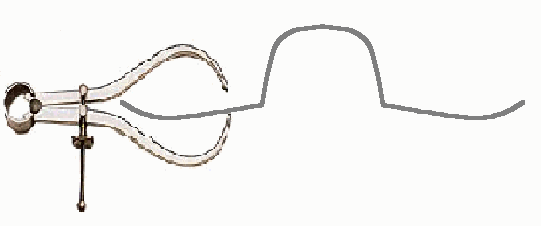
These calipers with matching legs are used to measure walls to a set size. You can adjust the amount of opening at the tip by turning the adjusting screw. This is very useful when the same setting on the calipers can access the entire object. When turning a hat these calipers are the tools of choice. When the object gets bigger your calipers must get bigger also, but the bigger ones are very expensive and hard to find (ask Steve Dunn).
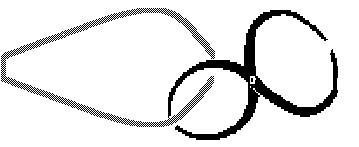
These calipers are normally rounded with matching shapes on both ends. Some have a different shape on each end but work the same way except you can get into more shapes with these. The important thing to remember is that the distance from the pivot to each end must stay the same, if they are different you will get a ratio of the true thickness. To use these calipers you put a leg on each side of the wall and close the tips onto the wall of your turning. By looking at the gap at the other end of the tool you can see how thick the wall is. You can use this type of caliper on open or closed forms with equal ease. The disadvantages of this system are you may need many different sizes and shapes for different turnings.
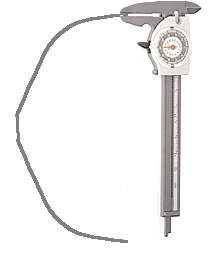
You can measure the walls of your turning with extreme accuracy with this tool. There are not to many times when you have to measure to thousands of an inch but when you do this is the right tool. Unless you make some kind of extension for the jaws you are limited to how far you can reach into your turning.
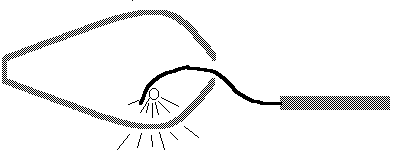
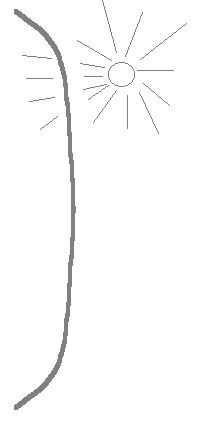
Wood can be translucent when a light is shined on it. Wet wood with a high water content can be very easy to see through (not quite like a window). Light colored woods can also be easy to see through. The dark colored and dense woods will be difficult or impossible to see through using any light system. When turning a bowl a light source placed behind the turning can show you that areas are thicker than others. The light coming through will be darker at the thicker areas. Light bulbs can put out a lot of heat, this can either dry out and crack your turning or cause it to warp while you are still trying to get an even wall thickness. You have to work fast or have a way to keep your turning cool. A small light can also be used inside closed forms. A 12-volt automobile light bulb can be ideal for this purpose. Frank Sudol uses this system to turn very deep vase forms (2íto 3í). With the light attached to your tool inside the turning you can see through the wall to see how even the thickness is. This approach also has the problem of heat, but with the small size of the bulb itís not as intense. You can set up this system for little cost, all you need is a 12 volt bulb, wire, transformer (110 volt to 12 volt), and a electric cord. If you are not electrically savvy get someone to help you set up your system. A non-heat producing light source is fiber optics. J. Paul Fennel uses this system on hollow forms. Light is conducted along a tube containing either glass or plastic fibers. The heat produced at the light source is not transmitted to the end of the fibers so the light is very cool at the tip. The light is also very concentrated and intense giving you an excellent look at the thickness of your turnings walls. The cost of a fiber optic system is a lot more than the light bulb but has many advantages that could offset this added expense. There are some problems with having a light source inside your turning. There are wires and bulbs inside that can get tangled up or you have the fiber optic cord to worry about (not cheap if damaged). Also the chips start building up obscuring the light coming through the wall. You have to stop the lathe and clear out the chips not only so you can see but also to keep the chips from compacting and grabbing your tool. This becomes an added problem because of the extra equipment inside your turning.
This is a new system that uses a small laser pointer to help you tell how thick the walls on your hollow form are. The laser must be attached to your tool in such a way for the light to shine down from above. You set the laser beam to shine down near the tip of your tool. The distance between the tool tip and the laser beam will be how thick the wall will be. When you still see the laser beam on your turning you are not yet to the correct thickness, when the laser beam goes off the side of your turning you have reached your preset wall thickness. This system is not expensive, a cheap laser pointer can be bought for about $20. The hard part is arranging a way of holding the laser above your tool tip in a rigid manor to keep the laser beam in one place.